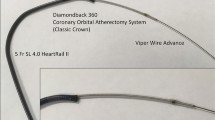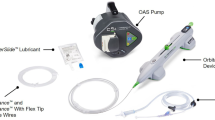Abstract
The Diamondback 360® coronary orbital atherectomy system (OAS) can safely debulk calcified lesions by pullback of the crown, if the crown is advanced to the distal of the lesion. The aim of this study was to compare crossability with two types of crown in OAS. Thirty-six consecutive severely calcified lesions in 33 patients who underwent percutaneous coronary intervention with the coronary OAS were included. The micro crown was used in 18 consecutive lesions from April 2018 to February 2019, and the classic crown with the glide assist was used in 18 consecutive lesions from March 2019 to August 2019. Good crossability was defined as the ability to cross the lesion before orbital atherectomy or to cross the lesion with a first session of orbital atherectomy. We also tried to elucidate whether the crown could cross the lesion without using the glide assist in 13 consecutive lesions at the end of the classic crown cases. Good crossability was more often observed in cases with the classic crown (17 of 18 lesions, 94%) than the micro crown (6 of 18 lesions, 33%) (P < 0.001). In 13 consecutive lesions at the end of the classic crown cases, the crown could cross the lesion in 4 lesions (31%) without use of the glide assist or orbital atherectomy, and in 11 lesions (85%) with only use of the glide assist (P = 0.005). The classic crown with the glide assist is superior to the micro crown in terms of crossability for severely calcified lesions.




Similar content being viewed by others
References
Grines CL, Cox DA, Stone GW, Garcia E, Mattos LA, Giambartolomei A, et al. Coronary angioplasty with or without stent implantation for acute myocardial infarction. Stent primary angioplasty in myocardial infarction study group. N Engl J Med. 1999;341:1949–56.
Stone GW, Lansky AJ, Pocock SJ, Gersh BJ, Dangas G, Wong SC, et al. Paclitaxel-eluting stents versus bare-metal stents in acute myocardial infarction. N Engl J Med. 2009;360:1946–59.
Fujii K, Carlier SG, Mintz GS, Yang YM, Moussa I, Weisz G, et al. Stent underexpansion and residual reference segment stenosis are related to stent thrombosis after sirolimus-eluting stent implantation: an intravascular ultrasound study. J Am Coll Cardiol. 2005;45:995–8.
Mosseri M, Satler LF, Pichard AD, Waksman R. Impact of vessel calcification on outcomes after coronary stenting. Cardiovasc Revasc Med. 2005;6:147–53.
Lindsay AC, Paulo M, Kadriye K, Tejeiro R, Alegria-Barrero E, Chan PH, et al. Predictors of stent strut malapposition in calcified vessels using frequency-domain optical coherence tomography. J Invasive Cardiol. 2013;25:429–34.
Genereux P, Madhavan MV, Mintz GS, Maehara A, Palmerini T, Lasalle L, et al. Ischemic outcomes after coronary intervention of calcified vessels in acute coronary syndromes. Pooled analysis from the HORIZONS-AMI (Harmonizing outcomes with revascularization and stents in acute myocardial infarction) and ACUITY (acute catheterization and urgent intervention triage strategy) TRIALS. J Am Coll Cardiol. 2014;63:1845–54.
Bhatt P, Parikh P, Patel A, Chag M, Chandarana A, Parikh R, et al. Orbital atherectomy system in treating calcified coronary lesions: 3-Year follow-up in first human use study (ORBIT I trial). Cardiovasc Revasc Med. 2014;15:204–8.
Chambers JW, Feldman RL, Himmelstein SI, Bhatheja R, Villa AE, Strickman NE, et al. Pivotal trial to evaluate the safety and efficacy of the orbital atherectomy system in treating de novo, severely calcified coronary lesions (ORBIT II). JACC Cardiovasc Interv. 2014;7:510–8.
Lee MS, Shlofmitz E, Kaplan B, Alexandru D, Meraj P, Shlofmitz R. Real-world multicenter registry of patients with severe coronary artery calcification undergoing orbital atherectomy. J Interv Cardiol. 2016;29:357–62.
Lee MS, Nguyen H, Shlofmitz R. Incidence of bradycardia and outcomes of patients who underwent orbital atherectomy without a temporary pacemaker. J Invasive Cardiol. 2017;29:59–62.
Lee MS, Shlofmitz E, Lluri G, Kong J, Neverova N, Shlofmitz R. Outcomes of patients with myocardial infarction who underwent orbital atherectomy for severely calcified lesions. Cardiovasc Revasc Med. 2017;18:497–500.
Shlofmitz E, Meraj P, Jauhar R, Sethi SS, Shlofmitz RA, Lee MS. Safety of orbital atherectomy in patients with left ventricular systolic dysfunction. J Interv Cardiol. 2017;30:415–20.
Meraj PM, Shlofmitz E, Kaplan B, Jauhar R, Doshi R. Clinical outcomes of atherectomy prior to percutaneous coronary intervention: A comparison of outcomes following rotational versus orbital atherectomy (COAP-PCI study). J Interv Cardiol. 2018;31:478–85.
Thygesen K, Alpert JS, Jaffe AS, Chaitman BR, Bax JJ, Morrow DA, et al. Fourth universal definition of myocardial infarction (2018). J Am Coll Cardiol. 2018;72:2231–64.
Huber MS, Mooney JF, Madison J, Mooney MR. Use of a morphologic classification to predict clinical outcome after dissection from coronary angioplasty. Am J Cardiol. 1991;68:467–71.
Tearney GJ, Regar E, Akasaka T, Adriaenssens T, Barlis P, Bezerra HG, et al. Consensus standards for acquisition, measurement, and reporting of intravascular optical coherence tomography studies: a report from the international working group for intravascular optical coherence tomography standardization and validation. J Am Coll Cardiol. 2012;59:1058–72.
Hayashi T, Tanaka Y, Shishido K, Yokota S, Moriyama N, Tobita K, et al. Wire bias, insufficient differential sanding, and orbital atherectomy-induced coronary pseudoaneurysm. Circ Cardiovasc Interv. 2018;11:e007003.
Funding
None.
Author information
Authors and Affiliations
Corresponding author
Ethics declarations
Conflict of interest
The authors declare that they have no conflict of interest according to this study.
Research involving Human Participants
All procedures performed in studies involving human participants were in accordance with the ethical standards of the institutional and/or national research committee (Institutional Review Board of Yokohama City University Graduate School of Medicine, 2019–080) and with the 1964 Helsinki declaration and its later amendments or comparable ethical standards.
Informed consent
Informed consent was obtained from all individual participants included in the study.
Additional information
Publisher's Note
Springer Nature remains neutral with regard to jurisdictional claims in published maps and institutional affiliations.
Rights and permissions
About this article
Cite this article
Gohbara, M., Sugano, T., Matsumoto, Y. et al. Is crossability of the classic crown with the glide assist superior to the micro crown in the Diamondback 360® coronary orbital atherectomy system?. Cardiovasc Interv and Ther 35, 361–370 (2020). https://doi.org/10.1007/s12928-020-00640-y
Received:
Accepted:
Published:
Issue Date:
DOI: https://doi.org/10.1007/s12928-020-00640-y




